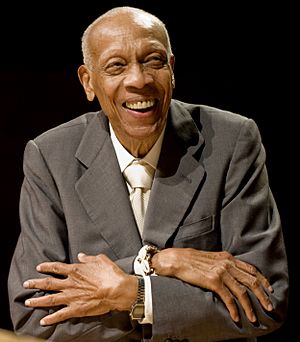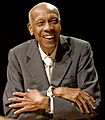Bebo Valdés facts for kids
Quick facts for kids
Bebo Valdés
|
|
|---|---|

Bebo Valdés in 2008
|
|
| Background information | |
| Birth name | Dionisio Ramón Emilio Valdés Amaro |
| Born | October 9, 1918 Quivicán, Cuba |
| Origin | Havana, Cuba |
| Died | March 22, 2013 (aged 94) Stockholm, Sweden |
| Genres | Afro-Cuban jazz, batanga, mambo, son cubano, bolero, guaracha |
| Occupation(s) | Musician, bandleader, composer, arranger |
| Instruments | Piano |
| Labels | Mercury, Decca, Panart, Gema, Blue Note, BMG |
| Associated acts | Julio Cueva, Orquesta Sabor de Cuba, Paquito D'Rivera, Diego El Cigala |
Dionisio Ramón Emilio Valdés Amaro (born October 9, 1918 – died March 22, 2013), known to many as Bebo Valdés, was a fantastic Cuban pianist, bandleader, composer, and music arranger. He was a very important person during the "golden age" of Cuban music. He was especially famous for his big band arrangements and his songs in styles like mambo, chachachá, and batanga. He even created the batanga style himself in 1952!
Bebo was the director of the house band at Radio Mil Diez and the orchestra at the famous Tropicana Club. Later, he started his own big band called Orquesta Sabor de Cuba in 1957. However, after the Cuban Revolution ended in 1960, Bebo left Cuba. He lived in Mexico for a short time before settling down in Sweden, where he got married again. He took a break from music until 1994, when he worked with another musician, Paquito D'Rivera. This brought him back into the music world. By the time he passed away in 2013, he had recorded many new albums and won several Grammy Awards. His son, Chucho Valdés, is also a very successful pianist and bandleader.
Contents
Biography
Early Music Days
Bebo Valdés was born Dionisio Ramón Emilio Valdés Amaro on October 9, 1918. He was born in a small village called Quivicán, near Havana, Cuba. He started his music career as a pianist in the nightclubs of Havana in the 1940s.
He joined Julio Cueva's band as a pianist and arranger. In 1946, the band recorded "Rareza del siglo," which became one of Bebo's most famous mambo songs. From 1948 to 1957, Bebo worked as a pianist and arranger for the famous singer Rita Montaner. She was the main performer at the Tropicana Club cabaret. Bebo's orchestra and another band took turns playing at the Tropicana, supporting singers like Benny Moré.
Bebo played a big part in changing mambo music so it could be played by big bands. Before him, mambo was mostly played by smaller groups. In the 1950s, he also created a new rhythm called batanga. He hoped it would be as popular as the mambo created by Perez Prado. The batanga was first played at the Tropicana in 1952. However, it didn't become as popular as another new rhythm, the chachachá, which was created by Enrique Jorrín.
Bebo was also important in the early days of Afro-Cuban jazz in Havana. He took part in recording sessions in 1952 for an American producer named Norman Granz. These sessions created famous improvised songs like "Con poco coco." In 1957, Bebo left the Tropicana Club to start his own orchestra, called Sabor de Cuba. They recorded songs with singers like Rolando Laserie and also instrumental music. His son, Jesús, who later became known as Chucho Valdés, started his career playing piano in Bebo's band when he was just sixteen.
In 1958, Bebo helped record the album Cole Español with the famous singer Nat King Cole. In 1959, he recorded several jam sessions (called descargas) with his orchestra. These included "Special del Bebo" and Cuban Dance Party, which was one of the first stereo albums recorded by a Cuban group. In 1960, Bebo left Cuba and went to Mexico with his band's lead singer, Rolando Laserie. He then lived in the United States for a short time before traveling around Europe. He eventually settled in Stockholm, Sweden, where he lived until 2007. In Sweden, he helped teach people about Cuban music and Latin jazz.
Coming Back to Music
Bebo Valdés's music career got a big boost in 1994. He teamed up with saxophone player Paquito D'Rivera to release a CD called Bebo Rides Again. In 2000, a movie called Calle 54 by Fernando Trueba showed his amazing piano playing to many people. This movie also showed Bebo working with his old friend Cachao for the first time on a recording. They worked together again on El Arte del Sabor, which also featured Carlos "Patato" Valdés.
In 2003, Bebo and Diego El Cigala, a famous Spanish flamenco singer, recorded the album Lágrimas Negras (which means Black Tears). This album mixed Cuban rhythms with flamenco singing. In 2004, Fernando Trueba filmed Bebo again in a movie called El milagro de Candeal. Later, Bebo wrote music for Trueba's 2010 film Chico and Rita, which even included parts of Bebo's own life story. The movie Chico and Rita ends with a special dedication to Bebo.
During his long career, Valdés was one of the people who helped create Latin jazz. He also helped bring sacred Afro-Cuban rhythms into popular dance music. He won seven Grammy Awards! He won two for El Arte del Sabor (in 2002), one for Lágrimas Negras, and two for Bebo de Cuba in 2006. One of his last music projects was recorded with his son, Chucho Valdés. It was called Juntos para siempre (meaning Together Forever) in 2008. This album won the Grammy Award for Best Latin Jazz Album in 2010. They also won a Latin Grammy Award for it.
In May 2011, Bebo Valdés received a special honorary music degree from Berklee College of Music.
Family and Later Life
Bebo Valdés was married to Pilar Valdés, and they had five children, including the famous pianist Chucho Valdés. In 1963, while on a tour with the Lecuona Cuban Boys, Bebo stopped in Sweden. There, he met Rose Marie Pehrson, who was 18 years old. They got married the same year, and he decided to live in Sweden. He said meeting her was the most important moment of his life. He felt it was like being "hit by lightning" and that he had to choose between love and his art. They stayed together until she passed away in 2012.
Bebo Valdés had been getting treatment for Alzheimer's disease for several years. He passed away in Stockholm, Sweden, on March 22, 2013, at the age of 94.
Images for kids
See also
 In Spanish: Bebo Valdés para niños
In Spanish: Bebo Valdés para niños


